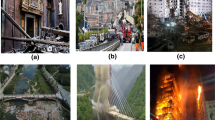Abstract
In recent years, various studies based on cyber physical systems (CPS) that integrate networking, computation, and physical processes have been actively carried out in different industries, national defense, and daily living. To physically reflect the theoretical aspect of CPS, consideration of various features is necessary to more easily integrate and effectively manage real-world components and the cyber world. This study suggests an adaptive resource management scheme (ARMS) to reduce the loss of sensing information and increase the level of accurate data obtained in the controller manager (CM) among the CPS components. A CPS-based system consists of a number of nodes (sensors and actuators) used to observe or monitor specific areas. ARMS utilizes data about the location and remaining battery capacity of each node to reduce the loss of information due to the irregular lifespans and unexpected breakdowns of resources in the CPS, and to obtain accurate data. Once a broken sensor in the physical world is sensed in the cyber world, the CM searches the locations of adjacent alternative nodes within a user-defined range based on the location of the broken node. In this process, an adjacent node search (ANS) algorithm is run to decide on a node (senor or actuator) to replace the broken node, taking into account the remaining battery capacity of candidate nodes. ARMS provides the adaptive resource management function of CPS by sending information on the identity (ID) and destination of the selected node to the controller to move the node to the destination and control the move.










Similar content being viewed by others
References
Wua F-J, Kaob Y-F, Tseng Y-C (2011) From wireless sensor networks towards cyber physical systems. Pervasive Mob Comput. Online published, doi:10.1016
Park SO, Do TH, Jeong Y-S, Kim SJ (2011) A dynamic control middleware for cyber physical systems on an IPv6-based global network. Int J Commun Syst. Online published, doi:10.1002/dac.1382
Zhou X, Ge Y, Chen X, Jing Y, Sun W (2012) A distributed cache based reliable service execution and recovery approach in MANETs. J Converg 3(1):5–12
Bandaranayake AU, Pandit V, Agrawal DP (2012) Indoor link quality comparison of IEEE 802.11a channels in a multi-radio mesh network testbed. J Inf Process Syst 8(1):1–20
Song Z et al (2009) Optimal observation for cyber-physical systems. Springer, London
Jovanov E, Milenkovic A, Otto C, de Groen PC (2005) A wireless body area network of intelligent motion sensors for computer assisted physical rehabilitation. J NeuroEng Rehabil. doi:10.1186/1743-0003-2-6
Park OP, Park JH, Jeong Y-S (2012) An efficient dynamic integration middleware for cyber-physical systems in mobile environments. Mob Netw Appl. doi:10.1007/s11036-012-0376-0
Singh B, Lobiyal D (2012) A novel energy-aware cluster head selection based on particle swarm optimization for wireless sensor networks. Hum-Cent Comput Inf Sci. doi:10.1186/2192-1962-2-13
Lee EA (2008) Cyber physical systems: design challenges. In: Int symposium on object/component/service-oriented real-time distributed computing (ISORC), May 2008
http://www.nitrd.gov/nitrdgroups/index.php?title=Cyber_Physical_Systems_(CPS_SSG)#title
CPSWeek. http://www.cpsweek.org/
Shi J, Wan J, Yan H, Suo H A survey of cyber-physical systems. http://www.cps-cn.org/Conference/CPS_Survey.pdf
Wayno W (2009) Cyber-physical systems. Computer 42(3):88–89
Blum J, Ding M, Thaeler A, Cheng X (2004) Connected dominating set in sensor networks and MANETs. In: Handbook of combinatorial optimization, pp 329–369
Cho H-S, Yoo S-J (2005) Power, mobility and wireless channel condition aware connected dominating set construction algorithm in the wireless ad-hoc network. J Korea Inf Commun Soc 30(5B)
Hong Y-S, Lim H-S (2010) A load-balanced topology maintenance with partial topology reconstruction. J Korea Inf Commun Soc 35(12):1188–1197
Wu J, Dai F, Gao M, Stojmenovic I (2002) On calculating power-aware connected domination sets for efficient routing in ad hoc wireless networks. J Commun Netw 4(1)
Acknowledgements
The research was supported by the Global Science experimental Data hub Center/KISTI in 2013.
Author information
Authors and Affiliations
Corresponding author
Rights and permissions
About this article
Cite this article
Jeong, YS., Kim, HW. & Jang, H.J. Adaptive resource management scheme for monitoring of CPS. J Supercomput 66, 57–69 (2013). https://doi.org/10.1007/s11227-013-0970-3
Published:
Issue Date:
DOI: https://doi.org/10.1007/s11227-013-0970-3




